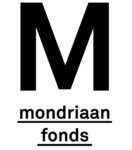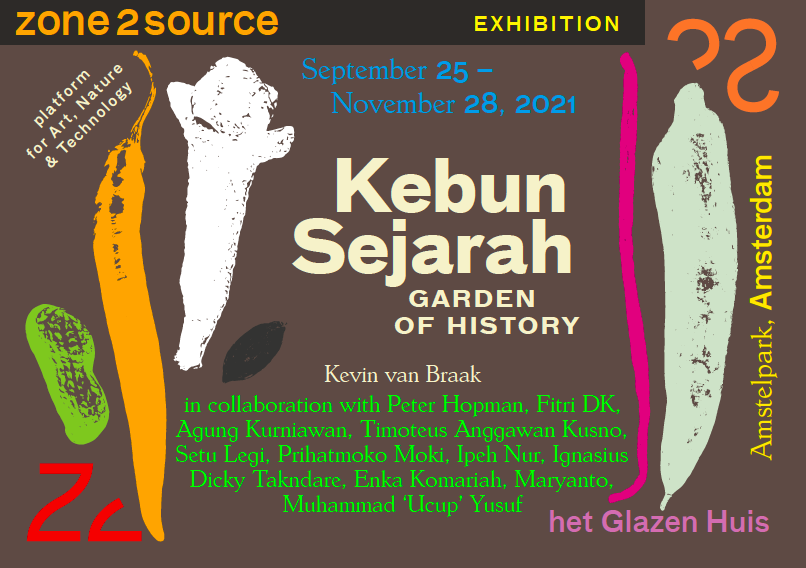Kevin van Braak: Kebun Sejarah / Garden of History
September 25 – November 28, 2021, with an official opening on October 1 at 15.00
Kevin van Braak in collaboration with Peter Hopman, Fitri DK, Agung Kurniawan, Timoteus Anggawan Kusno, Setu Legi, Prihatmoko Moki, Ipeh Nur, Ignasius Dicky Takndare, Enka Komariah, Maryanto, Muhammad ‘Ucup’ Yusuf.
Kebun Sejarah is an exhibition in the Glazen Huis in which an exchange between Kevin and ten Indonesian artists on the migration of plants and people is displayed. The show includes various culinary events, including a Sambal tasting on October 31, an educational finissage including coffee (cancelled), and an outdoor project Laid Back with seating elements in the Amstelpark.
The exhibition’s opening is on Friday, October 1, from 15.00 – 17.00 in the presence of Kevin van Braak, Peter Hopman, Ipeh Nur and an interactive performance by Setu Legi.
[Read on after this slider with image by Thomas Lenden]
History of Food Cultures
In the Amstelpark, Kevin van Braak is developing a project based on the history of food and crop cultivation concerning the botanical garden in Bogor in West Java. Kevin has been researching this topic for a while. This botanical is the oldest botanical garden in South-East Asia, founded in 1817 and managed for a long time by the Dutch colonial rulers. During the 19th century, the botanical garden was greatly expanded in terms of both space and diversity, which in the end, played a crucial role in the introduction of exotic plants into Indonesia.
In this project, Kevin connects the botanical garden of Bogor to another botanical garden, the Amstelpark. The Amstelpark was created for an international horticultural exhibition named the Floriade. While the Dutch crop and food culture has been influenced for centuries by Indonesian crops, which themselves transformed due to cultural exchanges, Indonesia was conspicuous by its absence at that second edition of the Floriade in 1972. Kebun Sejarah / Garden of History is a project in which the Indonesian-Dutch exchange through food cultures, migrations of crops and commonality in various ways still have a place in the Amstelpark 50 years after Floriade.
Cultural identities are developed around specific culinary traditions, which are often not native at all. Examples are the chilli pepper and sambal, peanuts and satay sauce, cassava, cocoa, coffee and tea, crops that have become part of culinary life in Indonesia. Yet these crops only reached Indonesia, and later the Netherlands, with the Columbian exchange, a period in which exchanges took place between the new and the old world in which Dutch world trade played a significant role. Kebun Sejarah takes the form of collaborative research and dialogue into how historical migrations of plants contribute to shaping cultures.
Greenhouses, Plants & Drawings
Kevin invited ten artists who he has worked with before – Fitri DK, Agung Kurniawan, Timoteus Anggawan Kusno, Setu Legi, Prihatmoko Moki, Ipeh Nur, Ignasius Dicky Takndare, Enka Komariah, Maryanto and Muhammad ‘Ucup’ Yusuf – to create drawings of ten different Indonesian crops. By highlighting each crop, an insight is given into the history and the place these crops occupy in the development of Indonesia. For each plant, Kevin worked in close dialogue with each artist who gave a critical drawn interpretation of the crop from their own – historical, socio-political – cultural perspective.
Ipeh Nur in the Rear Space
In the front space of the Glazen Huis, uniquely crafted glass greenhouses exhibit the plants together with the drawings to tell a complex story about the relationships between humans and plants. In the rear space of the Glazen Huis, we have invited the Indonesian artist Ipeh Nur to present a series of new drawings. She has done a lot of research into the history of various spices brought from Indonesia to the Netherlands. For this exhibition, she made a new work about cloves and nutmeg, two spices that initially occurred only in Indonesia, about the (colonial) history and the Moluccas.
Seating Elements
Another aspect of the project is a collaboration with designer Peter Hopman, with whom Kevin made seating elements from recycled plastic. The 40 half-spherical forms are new meeting places spread throughout the Amstelpark. They will also be used during special events where we will cook and eat together and talk to the artists and guests about stories of migrations of people and plants.
Brochure
Click on the cover and flip through the brochure of Kebun Sejarah (36 pp, full colour, in English), with background information about the exhibition by Alice Smits and Kevin van Braak, and descriptions of the various artworks by Danielle Hofmans based on her conversations with the artists.
Kebun Sejarah and Laid Back are supported by
![]()

























